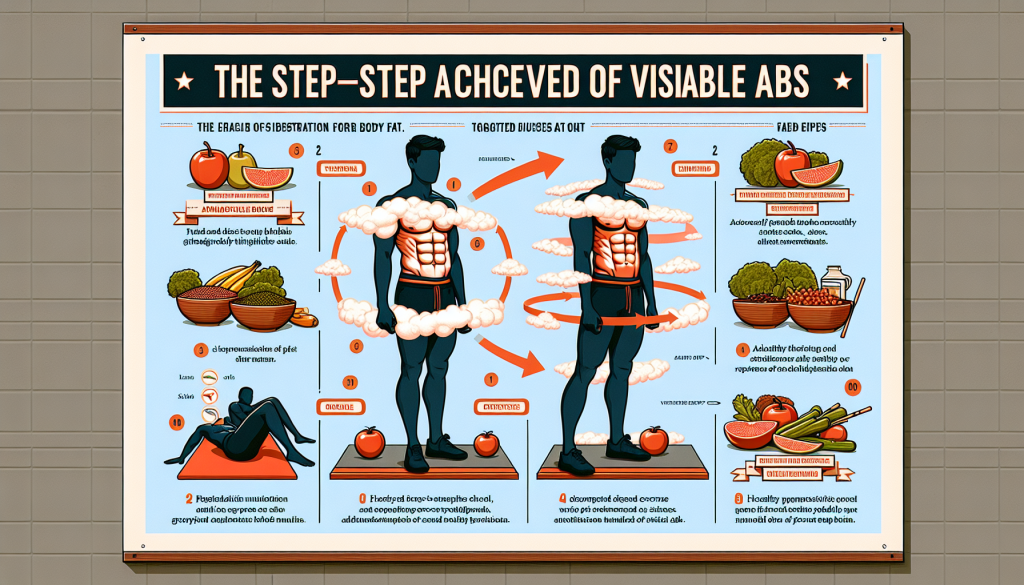Interested in revealing those elusive abs? Wondering how much body fat you need to shed to uncover your six-pack? Look no further! In this article, we will answer one of the most frequently asked questions about building strong core muscles and achieving a chiseled midsection. So, put on your workout gear and get ready to learn all about the magic number that will help you reach your ab-revealing goals!
Factors Affecting Abs Visibility
Genetics
Genetics plays a significant role in determining the visibility of your abs. Some individuals are genetically predisposed to store more body fat in the abdominal area, making it more challenging for their abs to become visible even at lower body fat percentages. On the other hand, some people may have naturally higher muscle definition in their abs, even with a slightly higher body fat percentage. While genetics cannot be changed, understanding your genetic predisposition can help you set realistic expectations for your abs visibility goals.
Overall Body Fat Percentage
The overall body fat percentage is perhaps the most crucial factor when it comes to having visible abs. To showcase your abs, you need to reduce your body fat percentage to a level where the abdominal muscles become more pronounced. Generally, for men, a body fat percentage below 10-12% is considered necessary for abs visibility. For women, the range is slightly higher, around 15-18% body fat. However, it’s important to note that these percentages may vary based on factors such as genetics, muscle mass, and personal preference.
Muscle Mass
Having a solid foundation of muscle mass can greatly contribute to the visibility of your abs. Muscles are more metabolically active than fat, meaning they burn more calories at rest. By increasing your muscle mass through resistance training, you can elevate your basal metabolic rate and enhance fat burning. Additionally, well-developed abdominal muscles will create a more sculpted appearance when body fat levels decrease. Incorporating compound exercises like squats, deadlifts, and planks into your workout routine can help you build a strong core and enhance muscle definition in your abs.
Gender
Gender also plays a role in the visibility of abs due to differences in body composition and hormonal factors. Generally, males tend to have a higher muscle mass and lower body fat percentage than females. However, it is essential to recognize that every individual’s body is unique, and there can be significant variations within genders. Women naturally carry a higher body fat percentage to support reproductive functions, and their abs may become visible at a slightly higher body fat percentage compared to men. Understanding these gender-specific differences can help set realistic expectations and goals for abs visibility.
Understanding Body Fat Percentage
Definition and Calculation
Body fat percentage refers to the proportion of fat tissue in relation to your total body weight. It is a more accurate indicator of your body composition than just body weight alone. Body fat percentage can be calculated using various methods, such as skinfold calipers, bioelectrical impedance, DEXA scans, or even visual assessments. By knowing your body fat percentage, you can have a better understanding of how much fat you need to lose to reveal your abs.
Ideal Body Fat Percentage for Abs Visibility
While determining the ideal body fat percentage for abs visibility can vary depending on factors like genetics, muscle mass, and personal preferences, it is generally recommended for men to aim for a body fat percentage below 10-12% to reveal their abs. For women, the range is typically around 15-18% body fat. However, keep in mind that these numbers are not fixed, and individuals may find their abs becoming visible at slightly different percentages. Experimentation and finding what works best for your body is key. It’s also important to prioritize overall health and well-being rather than solely focusing on achieving a specific body fat percentage.

Measuring Body Fat Percentage
Methods of Body Fat Measurement
There are several methods available to measure body fat percentage, each with its own level of accuracy and convenience. Skinfold calipers involve taking measurements of skinfold thickness at specific sites on the body, and the result is used to estimate body fat percentage. Bioelectrical impedance analysis (BIA) devices send a safe electrical current through the body, measuring resistance to estimate body fat percentage. Dual-Energy X-ray Absorptiometry (DEXA) scans provide highly accurate measurements by using X-ray technology to differentiate between fat, muscle, and bone. Visual assessments, while less precise, can also give a general indication of body fat levels. Choose a method that suits your needs and consult with a healthcare professional or fitness expert for accurate results.
Accuracy and Limitations
Each method of measuring body fat percentage has its own limitations and potential sources of error. Skinfold calipers rely on the accuracy of the measurer and may have a margin of error. BIA devices can be influenced by factors such as hydration levels, meal timing, and the presence of certain medical conditions. DEXA scans are considered the gold standard but may not be easily accessible or affordable for everyone. Visual assessments can give you a rough estimate but may not be as accurate as other methods. It is important to recognize the limitations of each measurement technique and use them as a tool for progress tracking rather than getting hung up on specific numbers.
Setting Realistic Goals
Consulting with a Fitness Professional
When it comes to setting realistic goals for abs visibility, consulting with a fitness professional can be incredibly valuable. They can help assess your current body composition, discuss your goals and limitations, and provide personalized guidance. A fitness professional can also help you create a realistic timeline, set achievable targets, and design a customized exercise and nutrition plan that suits your individual needs. Their expertise and knowledge will ensure you have a solid foundation for your journey towards abs visibility.
Considering Individual Factors
It is crucial to consider individual factors when setting goals for abs visibility. Factors such as age, fitness level, medical history, and lifestyle commitments can all impact the pace of progress. Recognizing that everyone’s body is different and progress may vary can help you maintain a positive mindset and avoid comparing yourself to others. Embrace your own unique journey, and remember that slow and steady progress is often more sustainable and long-lasting.

Effective Strategies for Fat Loss
Calorie Deficit
Creating a calorie deficit is a key component of fat loss. This means consuming fewer calories than your body needs for its daily functions, forcing it to tap into stored fat for energy. To achieve a calorie deficit, you can reduce your overall calorie intake by making mindful food choices, practicing portion control, and incorporating lower-calorie alternatives into your meals and snacks. It is important to create a moderate calorie deficit to avoid nutrient deficiencies or metabolic slowdown. Aim for a deficit of 300-500 calories per day to facilitate gradual and sustainable fat loss.
Balanced Diet
In addition to creating a calorie deficit, fueling your body with a balanced and nutritious diet is essential for fat loss and overall health. Include a variety of nutrient-dense foods such as lean proteins, whole grains, fruits, vegetables, and healthy fats in your meals. These foods provide the necessary vitamins, minerals, and antioxidants to support your body’s functions and promote fat loss. Be mindful of your portion sizes and listen to your body’s hunger and fullness cues. Avoid restrictive diets or quick fixes, as they are often unsustainable and can lead to nutrient deficiencies or disordered eating patterns.
Cardiovascular Exercise
Incorporating cardiovascular exercises into your fitness routine can help boost calorie expenditure and accelerate fat loss. Activities such as running, cycling, swimming, or HIIT (High-Intensity Interval Training) workouts can effectively enhance your cardiovascular health and burn excess calories. Aim for at least 150 minutes of moderate-intensity cardio or 75 minutes of vigorous-intensity cardio per week, as recommended by the American Heart Association. Cardiovascular exercise not only aids in fat loss but also improves cardiovascular fitness, strengthens the heart, and enhances overall well-being.
Resistance Training
Resistance training, which includes activities like weightlifting or bodyweight exercises, plays a vital role in preserving and building lean muscle mass. By increasing muscle mass, you can elevate your metabolism, as muscles require more energy to maintain than fat. This leads to increased calorie expenditure even at rest, contributing to overall fat loss. Additionally, resistance training helps shape and define your abs, making them more visible as body fat percentage decreases. Incorporate compound exercises that engage multiple muscle groups, such as squats, deadlifts, push-ups, and planks, into your workouts to maximize muscle-building and fat-burning potential.
Monitoring and Adjusting Progress
Regular Body Fat Testing
Regularly monitoring your body fat percentage is crucial for evaluating progress and making necessary adjustments to your fitness and nutrition plans. Depending on the method you choose, it is generally recommended to measure body fat every 4 to 8 weeks to track changes over time. Ensure you use the same measurement method consistently for accurate and reliable results. Keep in mind that progress may not always be linear, so focus on overall trends rather than daily fluctuations. Celebrate even small victories and use any setbacks as opportunities to learn and refine your approach.
Tracking Caloric Intake and Expenditure
To maintain a calorie deficit and continue progressing towards abs visibility, it is important to monitor your caloric intake and expenditure. Tracking your food and beverage consumption using a food diary or mobile apps can provide insights into your eating habits and help identify areas for improvement. Similarly, monitoring your exercise and physical activity levels can help ensure you are consistently meeting your weekly cardio and resistance training goals. By tracking these variables, you can make adjustments as needed to stay on track and achieve your desired body fat percentage.

Maintaining a Healthy Lifestyle
Sustainable Fat Loss
While achieving abs visibility may be a short-term goal, it is important to approach fat loss with a long-term mindset. Rapid weight loss or extreme dietary restrictions are often unsustainable and may lead to muscle loss or rebound weight gain. Focus on making gradual and sustainable lifestyle changes that allow for proper nourishment, physical activity, and enjoyment of life. Aim for a slow and steady fat loss of 1-2 pounds per week, as this is more likely to lead to lasting results and minimize negative health effects.
Importance of Proper Nutrition
Nutrition plays a critical role not only in fat loss but also in overall health and well-being. Maintain a balanced and varied diet that provides essential nutrients, including carbohydrates, proteins, fats, vitamins, and minerals. Opt for whole, unprocessed foods whenever possible and limit your intake of sugary drinks, processed snacks, and foods high in saturated fats and added sugars. Hydration is also essential, so be sure to drink enough water throughout the day. Prioritize healthy eating habits that you can sustain for the long term, as they will contribute to both abs visibility and overall wellness.
Consistency and Persistence
Consistency is key when it comes to achieving and maintaining abs visibility. Make a commitment to prioritize your physical and mental well-being, and stick to your exercise and nutrition plans even when faced with challenges. Remember that progress takes time and effort, and setbacks are a natural part of the journey. Stay persistent and trust the process, knowing that consistent dedication will yield results. Surround yourself with a supportive network, celebrate small victories, and focus on the positive changes you experience along the way.
Additional Tips and Considerations
Timeframe for Abs Visibility
The timeframe for achieving visible abs can vary greatly depending on individual factors, such as starting body fat percentage, genetics, and overall lifestyle. While it is possible to see some changes within a few months, it may take longer to achieve the level of definition desired. It is important to set realistic expectations and be patient with the process. Focus on sustainable habits and progress rather than becoming fixated on a specific timeline. Remember, everyone’s journey is different, and the most important thing is to prioritize your overall health and well-being.
Importance of Overall Fitness
While having visible abs can be a desirable goal, it is essential to prioritize overall fitness and well-rounded physical development. Engage in a variety of exercises that challenge different muscle groups and improve flexibility, stamina, and functional strength. Incorporate activities you enjoy, such as sports, yoga, or dancing, to make your fitness routine more enjoyable and sustainable. Focus on overall health markers, such as cardiovascular fitness, muscular strength, and flexibility, as they are important indicators of a well-rounded fitness level.
Potential Health Risks
It is important to address any concerns regarding fat loss and abs visibility with a healthcare professional or fitness expert. Extreme dieting or excessive exercise can have negative health consequences such as nutrient deficiencies, muscle loss, hormonal imbalances, or increased risk of injury. If you have any underlying medical conditions, are taking medications, or have specific dietary requirements, consult with a healthcare professional before making significant changes to your exercise or nutrition plan. Remember, the goal should always be to prioritize both physical and mental well-being throughout your journey.
In conclusion, achieving visible abs requires a combination of factors, including genetics, body fat percentage, muscle mass, and gender. Setting realistic goals, implementing effective fat loss strategies, and maintaining a healthy lifestyle are essential for long-term success. Prioritize overall health and well-being above a specific body fat percentage, and remember that progress takes time and consistency. With dedication, patience, and the right approach, you can work towards revealing those sought-after abs and enjoy the benefits of a fit and healthy body.






